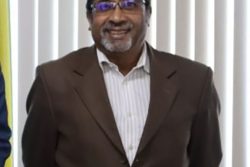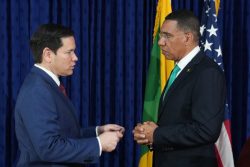Main Street certainly fulfilled all the expectations of the city’s forefathers from the date it was christened, and matches Brickdam, our oldest street, for popularity and prominence.
To start at the beginning of the twentieth century, our National Library was built and opened in 1909, following a grant from philanthropist, Andrew Carnegie. Thou-sands of Guyana’s sons and daughters have since browsed among its tomes.
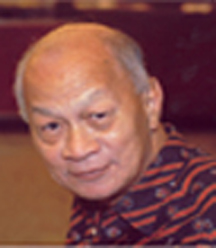
Our nation’s pomp and pageantry started opposite the library, when that fountain was replaced by the War Memorial, (incorrectly called the Cenotaph), and from 1925 witnessed our annual Remembrance Day, the laying of wreaths by governors, presidents, prime ministers and dignitaries honouring the dead of World Wars I and II. Indeed, every schoolchild was granted the opportunity yesteryear to participate and support by purchasing for a penny a red poppy in homage.
For Queen Elizabeth’s coronation in June 1953, the Avenue was a veritable fairyland, with coloured bulbs hanging profusely overhead, to match the Union Jack flags and pennants, fluttering on the vacant site where the Bank of Guyana now stands. Annually on Empire Day, Queen Victoria’s Birthday, as well as VJ Day, contingents of our local military forces – police and army – scouts, social organizations and senior students would march northwards to rousing tunes by the Militia Band, for salutes by the governors at Government (now State) House.
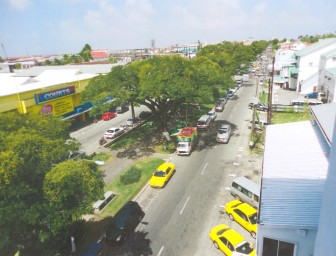
Three of our most massive parades were staged southward on Main Street. The first was the occasion of the visit of Princess Margaret in 1958, where a flotilla of floats and costumed bands, justified the overseas press heralding this parade as matching the Lord Mayor’s Show in London. The evening parade on February 7, 1962, for the visit of Prince Phillip was also historic, when the ‘Jack go Back’ float embarrassed the government. The third parade was in 1971 at Mashramani.
For Independence Day, May 26, 1966, Main Street was decorated with the Golden Arrowhead flags strung vertically down, across the street. These blew onto themselves, until the committee had the bright idea of adding two more feet of white cloth to weigh down the flag. My first thought was, it looked like ‘we hanging our dirty linen in public.’
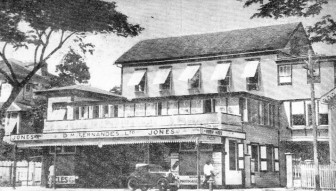
Our big pageant annually is the Main Street Lime on Boxing Day – standards having changed from the pageants of yesterday to bustling street limes. Ya think it easy, when even yesteryear’s afternoon enjoyment of musical interludes at the Bandstand, Sea Wall is replaced by noisy, ear-crushing, heart-throbbing, juke-box limes today?
But while every street has two sides, Main Street had another face. Prior to 1923 the avenue was a canal where the citizens could steal a swim. Today, we can’t swim there, but must wade in the city after every heavy rainfall.
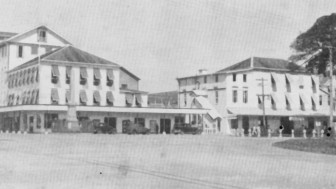
Today, Georgetown boasts one of the most spacious downtown shopping centres in the Caribbean, thanks to that Black Friday fire on February 23, 1945, which started at Bookers Drug Store (opposite the library ) and destroyed 23 major buildings, with approx $18M in damage.
Three other major conflagrations scarred Main Street: the Park Hotel fire in 2000; the Sacred Heart Church fire on Christmas Day, 2004; and only recently on January 10, the one at the Frandec Building at Holmes St, which was formerly the R G Humphrey Cigarette and Tobacco manufacturing facility (1937).
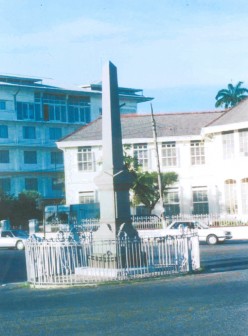
In the late forties, the youngsters from the Tiger Bay area would gather at the entrance of the Park Hotel to beg the guests for ‘frecks’ so they could buy sweets and confectionery from that popular candy store next to the ‘Londonburg’ (later known as the ‘Cambridge,’ which had its counterpart across the road called the ‘Oxford’). Ms Doris Lancaster who worked for over sixty years at the Park Hotel, lamented in her retirement that her biggest challenge was keeping the urchins away from pester-ing the guests.
Officialdom has always been represented on Main Street in the form of the governors (now the President. The AG’s Chambers is now the Walter Roth Museum, and the Prime Minister’s House was earlier the British High Commissioner’s home – having passed through various hands before that. The British High Commission itself is still located on the opposite side of the street.
Before we attained independence, the US Information Services Library was located on the western side, while the US Embassy replaced the Esso Head Office in 1975 at Bentick Street, before moving to Kingston, later. The Daily Chronicle, founded in 1881 by Scotsman, Charles Kennedy Jardine, was started on Hincks Street, with the presses on Main Street, as the century turned. This edifice survived the Booker fire, though it was just 10 ft away to the north. It later moved to the Guyana Graphic premises in Bel Air Park. On the ground floor of the Chronicle in the late forties a Stuart Surridge cricket bat was available for $18, a Nonjar for $14 plus a wide variety of toys and gifts.
Demba built its head office at the north-eastern corner of Murray Street (now Qua-mina). This beautiful Demerara-windowed edifice now houses our Ministry of Culture, Youth and Sport. At Lamaha Street, the former Transport and Harbours Department is now the Ministry of Finance.
When Art Williams, the aviation pioneer who opened up our vast hinterland, sold his BG Airways in 1955 to the government, the head office on Main Street, became BG Airways and late GAC. Today it is the New Thriving restaurant .
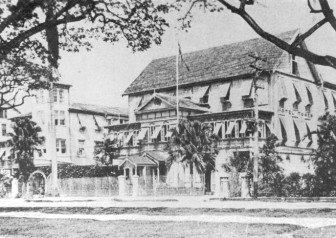
Main Street boasted the best George-town cake shop/parlour – Ferraz – that sold that famous peanut punch, puri and potato ball, plus tennis roll and cheese. Ferraz introduced bubblegum and crackerjack during WWII; the building later became Banks DIH’s Arapaima restaurant. Today, it is a Banks Quick Serv Outlet.
Hotel Tower opened for business in 1907, while Trent House next door, with the popular Punchbowl bar, is now a vacant lot.
D M Fernandes distributors of Raleigh Cycles and Jones Sewing Machines, and Joe Chin’s Travel Service founded in 1959 are defunct, while Geddes Grant with the NCR Office and retail supplies is no longer there. Courts, the furniture giant, now occupies that building. There were also several commission agencies expanding our export and import trade.
Private residences on Main Street in-cluded the Psaila’s, Jaikaran’s, Rahaman’s, Sankar’s and today the Kissoon’s. Palm Court, a popular watering hole since the forties, is now being completely rehabilitated. For the jet set, there is toaday Mojo’s and the Edge.
For more Nostalgias go to Godfrey Chin at Google or check out Godfrey’s Nostalgias – Golden Memories of Guyana 1940 to 1980, available at Austin’s Bookstore or Sol Gas Station, Vlissengen Rd.







